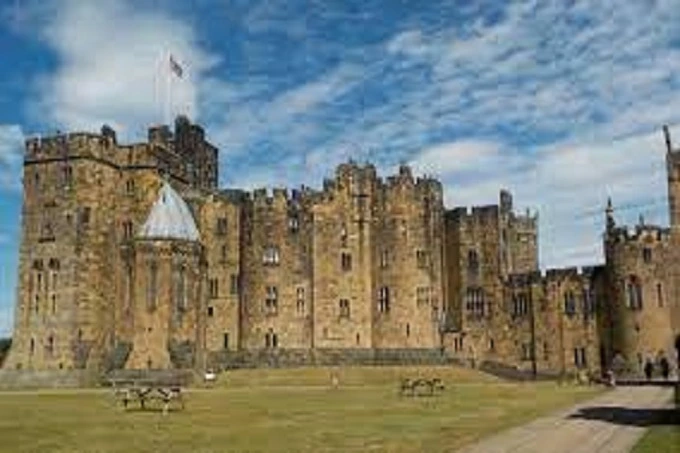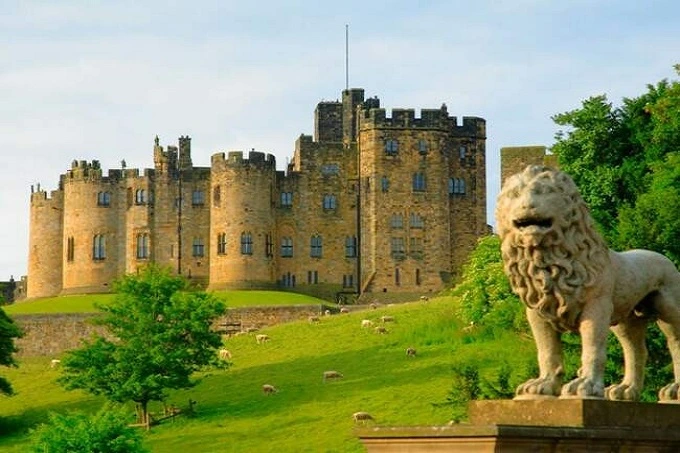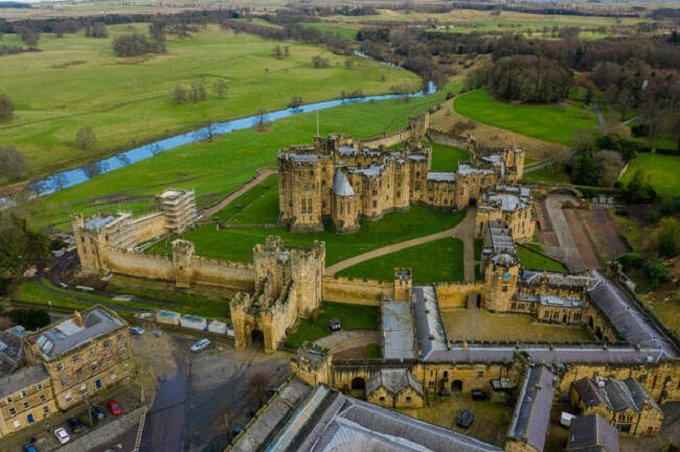The ancient castle of Alnwick

The historic Alnwick Castle is more than just a magnificent edifice; it has been meticulously maintained over the years. Even though the medieval outpost became well-known worldwide due to the filming of several fantasy films about Harry Potter, the building’s architecture is deeply embedded in a troubled history and several mysteries that have yet to be resolved and deserve special attention.
The crown jewel of Northumberland

The historic Alnwick Castle is more than just a majestic building; it has been meticulously maintained over the years. Even though the medieval outpost became well-known worldwide due to the filming of several fantasy films about Harry Potter, the building’s architecture is deeply embedded in a troubled history, and many mysteries that have yet to be resolved deserve special attention.
This majestic architectural complex has not only maintained its impressive appearance, which, by the way, attracts lovers of antiquity and filmmakers, but it is also one of the few that is still quite inhabited by the descendants of those who built it several centuries ago and tried to protect it from the encroachments of ill-wishers.
This architectural complex has not only maintained its impressive appearance, but it is also one of the few that is still quite inhabited by the descendants of those who built it. However, because of the outpost’s position on the boundary between England and Scotland, there were a significant number of the latter throughout the troubled existence of the settlement. Although the stubbornness of the owners sometimes led to the loss of it, and sometimes even to the death of the obstinate subjects.
The history of the construction

The trading town of Alnwick, and the lands surrounding it (located in the north of England, not far from the southern borders of Scotland), have been a kind of prize for good service to the king since time immemorial. They were very easily granted to loyal subjects and were easily taken away if they allowed their willfulness, participated in conspiracies, or rebelled. The first gifted was the standard-bearer of William the Conqueror – the Norman Gilbert de Tesson. In the XI century. A brave standard-bearer in the west of the city, on the banks of the river Aln, built a wooden fortress where he lived not so long. A few years later, he joined the rebels, rebelling against his benefactor – William II, for which he was deprived of these lands.
Up to the beginning of the 14th century, several individuals had been bestowed with such gifts; some of these individuals even acquired these lands twice or even three times (the complex relationship with the crown is to blame). Naturally, some people refused to freely give up the land, which resulted in the citadel being besieged many times and eventually being taken by enemy forces, if not destroyed. It is important to note that one of those fortunate people who could get their goods back (Ivo de Vesci ) began a huge building project, which resulted in the appearance of a stone castle that included a beautiful dwelling at the time.
The Earls of Northumberland
In 1309, perhaps for the first time, land holdings, including the city, Alnwick Castle, farmland, and woodland, were sold, interrupting the chain of gifts and the constant change of owners. The new owner turned out to be one of the representatives of the Percy family. This is one of the most powerful English families, whose representatives were distinguished by their hot and restless disposition. From generation to generation, there were hotheads, military leaders, knights, and rebels who now and then fell into disfavor with the ruling dynasty, adversely affecting the fortress and castle itself. Not only did its walls constantly suffer from attacks, but also, because of the execution of the head of the clan (by that time, the Percy family had received the title of earls of Northumberland), the castle was abandoned.

One of the first owners of the castle, then Alnwick County, was Sir Henry Percy, nicknamed Hot Spur. He became the prototype of the characters in the historical chronicles of William Shakespeare’s “King Richard II” and “King Henry IV.” By the way, not only were daredevils and military leaders in the family, but more often, the family weaved intrigues against the monarchs and constantly rebelled against the English and Scottish kings. Even Henry Percy lost the castle for a while and almost lost his head. Fortunately, the dodgy owner returned the county to the family and even renovated the fortress so thoroughly that some of the buildings have survived.
The castle was reconstructed throughout many generations by a well-known family, giving it a different look. In addition to its severity and invulnerability, it had a variety of distinct distinctions in comparison to the fortifications that were common at that age. The fortress did not include a castle; instead, the home of the counts was constructed all around a massive courtyard, inside which the public square was outfitted. The actual stronghold was protected on all sides by a formidable wall with watchtowers spaced at equal intervals throughout its perimeter. They provided a place for the regiment to live and storage for ammunition, weapons, and provisions.
It is worth noting that the family’s ambitions were so great that they did not want to lag in the luxury of the royal palaces or the splendor of landscaped parks and gardens. Despite the harsh and impregnable appearance of the architectural complex (circumstances forced it because Alnwick, as before, was attacked), inside the castle reigned extreme luxury, in no way inferior to Victorian beauty and an abundance of decor to the main royal residences of the wealthy states of Europe. It is believed that Alnwick Castle became a “British response to Versailles.”
In 1766, after another ruin and capture, the county returned to the Percy clan, whose representatives were awarded the title of the Dukes of Northumberland (still, the descendants of the legendary family bear this title). By the middle of the 19th century, the dynasty not only restored the lost grandeur of the castle but also began a grandiose reconstruction because times had changed and fashion trends had also changed. During the transformation, cardinal changes did not so much with the appearance of the architectural ensemble. The interiors have become more refined and refined: marble staircases and fireplaces, damask silk draperies, antique furniture, unsurpassed collections of art, Meissen porcelain and antique silver, and the Museum of Antiquities, which contains artifacts from around the world. The garden and park ensemble was also updated.
It should come as no surprise that Alnwick Castle has many stories attached to it, the most intriguing of which is the story of a vampire lord who passed away in the 12th century. The castle has a long and illustrious history, dating back hundreds of years. Two centuries later, during the Black Death, local peasants recalled the tale of how during his lifetime, he attacked and murdered anybody who ventured close to the castle. According to the story, he did this by attacking everyone who came near the castle. At that time, the lord was identified as a vampire responsible for sending this assault on the people. People who were at their wits’ end were the ones who dug up the lord’s bones from his grave and set fire to them in the hope that the disease would subside and the deaths would cease. The horrible sickness subsided over time, and the legend grew so ingrained that the people continued to believe in a vampire dwelling in a dungeon who roamed about the grounds of the castle for another 500 years after that. Despite this, there are still individuals living in the area who claim to have seen a shadowy creature that roams its old territory at night.
Tourist Attraction
Alnwick Castle is still the property of the Dukes of Northumberland to this day; however, most of it is open to the public (during the summer months). If earlier only lovers of antiquity were asking for excursions, then thanks to cinematography, it has become a tourist mecca for fans of Harry Potter and not only. Given that its walls have retained a medieval atmosphere and harsh impregnability, it attracts filmmakers who prefer not computer graphics but living nature.
In fairness, it should be noted that not only the famous scenes of a fantasy hero flying on a broomstick were filmed at Alnwick Castle. In 1982, director Douglas Camfield filmed part of the plot of the television movie Ivanhoe (a film adaptation of the novel of the same name by Walter Scott). The majestic medieval castle can also be seen in the historical drama of Julian Fellowes – “Downton Abbey” (Season 5, 2010). The 12th Earl of Folgan from the American science fiction action movie “Transformers: The Last Knight,” created by director Michael Bay, also lived in it. Some scenes from famous television series were filmed in its atmospheric territory, including “Elizabeth,” “Robin Hood: Prince of Thieves,” etc.
Even though the Harry Potter films helped the castle become more well-known. The Hogwarts School of Witchcraft and Wizardry, which served as the setting for the first two films, was situated here, and it included the same Great Hall, Professor Dumbledore’s office, and the fabled library. Broom flying and many more fantastic exploits were practiced close to Alnwick’s medieval walls.
There are plans to establish a fantasy character museum in this area, which would display costumes, “magic” items, movie scenes, and various works of art that were made in the areas where the most cherished movie sequences were filmed. While this happens, costume parties and other events are planned, when certain scenes, such as broom flying, are recreated.




